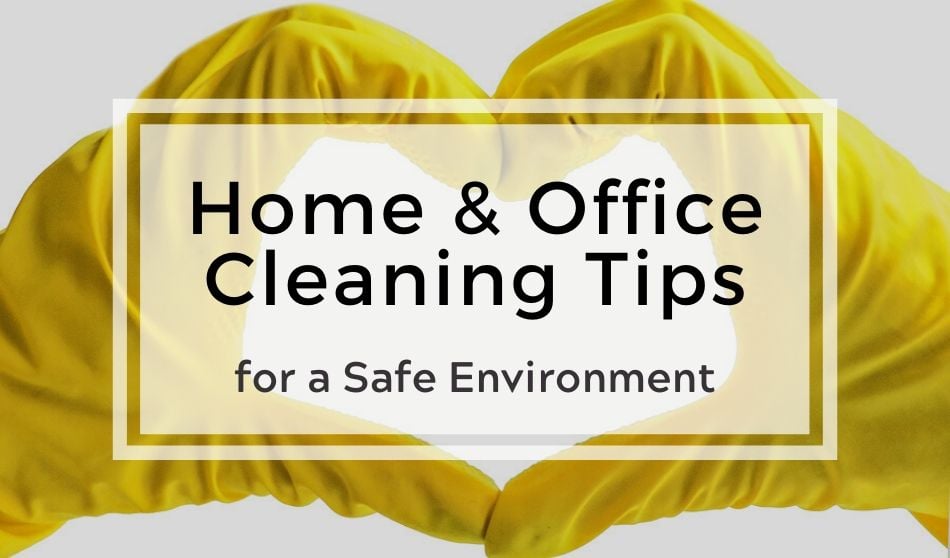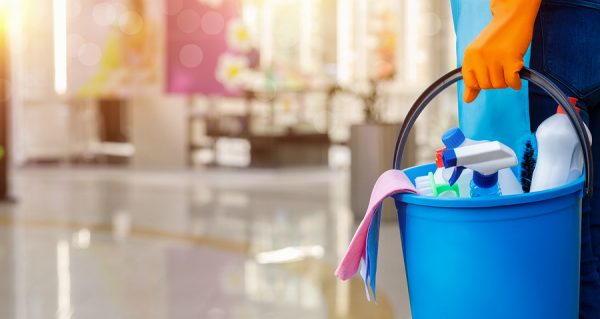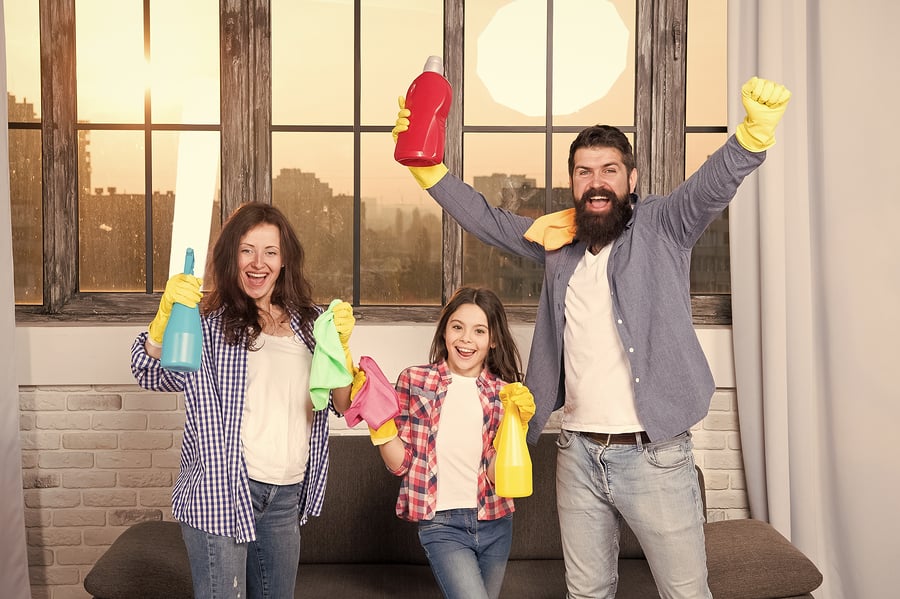
Each action we take, no matter how small, has an impact on those around us. Keeping homes and offices clean is now more important than ever to create a safe environment. From rental properties to the general public, these helpful cleaning tips make for a safer environment to live and work.
The Big Three Important Tasks
The objective isn’t to reorganize every draw or system you have in place. That can come next when necessary or when boredom sets in – whichever comes first. For now, the goal is to create a safe work and home environment. For those working from home, it’s one and the same.
It might feel daunting knowing where to even start. Breaking it down to smaller steps can make things a little easier. The three main important tasks are: decluttering, cleaning, and disinfection.
Step 1 – Decluttering Home and Office
Clutter not only can be a source of stress in a home or office, but it also can impede cleaning. It’s very difficult to clean an area when items are blocking that task.
One method of dealing with clutter quickly is to group similar items together and take them to a specific place.
Start with the common clutter offenders:
- Gather all dishes and place in the sink
- Place dirty laundry into a plastic bag or hamper and take them to the laundry room or other designated area
- Put all paper items in a box to sort through later
- Gather up any items that should be discarded
If you have books about, place them in a box or on a shelf but avoid the temptation to reorganize that shelf. Same with shoes and coats. Again, organizing can occur at a later time. Try to stay focused only on the goal of getting items off of surfaces so you have access to clean them.
Important Note: special consideration is recommended that in times of infection wear disposable gloves (or dedicated gloves that can be washed) when handling items such as dishes or laundry.
Step 2 – Importance of Deep Cleaning BEFORE Disinfection
Now that items are grouped by type, moved, and surfaces have been exposed it’s time to remove the dirt and grime.
The U.S. Centers for Disease Control and Prevention (CDC) recommends cleaning dirty surfaces using a detergent or soap with water prior to disinfecting. Diving straight to disinfection before proper cleaning may thwart your disinfecting efforts.
In each room:
- Conduct top-down dusting, remove cobwebs, and clean ceiling fans and vents first so that the debris will fall on areas yet to be cleaned.
- Secondly, clean walls and cupboards; again from the top down.
- Move on to cleaning flat surfaces such as countertops and tables.
- Lastly, sweep and vacuum prior to mopping.
In general, it is recommended to wear gloves when dealing with cleaning and disinfecting solutions to protect your hands from the harsh chemicals. In addition, consider creating cleaning zones and use different colored gloves for bathroom cleaning versus kitchen tasks.

Remember to wear gloves when cleaning or disinfecting to protect your hands from harsh chemicals and also from infection.
Step 3 – Effective Disinfection
Now that the cleaning is done, it’s time to disinfect.
The CDC recommends daily disinfection for surfaces that are frequently touched. Surfaces such as doorknobs, light switches, handles, desks, keyboards, phones, countertops, tables, toilets, faucets, and sinks, etc.
Let the disinfecting agent remain on the surface the recommended length of time noted on the product label to allow it to complete the task of killing pathogens. It varies by type of disinfectant to be sure to read labels.
In addition to the branded solutions you can purchase, according to the CDC, there are two household products that are known to be effective against coronaviruses and other bacteria in general.
Chlorine/Hypochlorites
Bleach is the common household name for sodium hypochlorite and useful for disinfection when properly diluted. The potency and effectiveness of a bleach solution diminish with time so only make what you need to use for a 24-hour period. It can also be corrosive on certain surfaces.
Alcohol
Alcohol at the proper concentration can also be an effective substance for killing pathogens and viruses. If the alcohol concentration is too low it will not be effective and too high it evaporates too quickly for usefulness. The recommended concentration is between 60-70% alcohol.
As long as the solution remains sealed, unlike bleach, it will retain its potency long term. Keeping a 70% alcohol solution sealed also keeps it from evaporating too quickly.
Hand sanitizers have a concentration closer to 60% as a higher amount is very harsh on the skin. Hand sanitizer use should be reserved as the second line of defense after handwashing or when hand washing is not available.
Important note: Many cleaning and/or disinfecting products become extremely hazardous when mixed together. The mixture can create a chemical reaction producing poisonous gases that are highly dangerous. Read and follow all product label instructions.
… AND Repeat
Especially to halt the spread of infection, cleaning and disinfecting is an ongoing task. How often should you clean and disinfect is dependent on how often items are used. During times of infection, cleaning and disinfecting as-you-go might be the best route to take. As you use a space or item, take the time to then clean up and quickly disinfect the area before going on to the next activity you’ve planned.
For instance, you may be in the habit of leaving dishes as an evening chore, but consider tackling cleaning as you prep and cook. Then, either right before or right after eating the meal, finish cleaning any items still remaining.
Another idea would be to run laundry as soon as a load is available to wash instead of waiting for a scheduled laundry day.

Cleaning can be fun and satisfying knowing it benefits everyone
Often Forgotten Items to Clean and Disinfect
Commonly touched items like keyboards and phones are often on the checklist. Consider adding these often overlooked items to your cleaning and disinfecting routine:
Vehicles
- Steering wheels
- Consoles
- Cupholders
- Door handles inside and out
Kitchen
- Refrigerator and freezer doors and handles
- Microwave inside and out
- Cupboard knobs
- Overhead stove fan filter
Laundry
- Washer and dryer doors and controls
- Laundry hampers and baskets
Bathroom
- Ceilings to remove mold and mildew spores
- Shower curtains
- Toilet paper holders
Bedroom
- Regular sheet and pillowcase changes
- Nightstands and lamps
Office
- Headsets
- Writing utensils: pens/pencils/markers
- Office equipment such as printer controls
- Often used tools such as hole punches and staplers
- Information binders
Miscellaneous
- Change out HVAC air filter
- Remote controls
- Exterior home and/or office door handles
- Children’s toys
- Stair railings
- Laundry baskets and hampers
- Garbage cans and baskets
YOU
Be sure to wash and disinfect your hands after:
- Touching shared items
- Sneezing or coughing
- Preparing food
- Taking out the garbage
- Cleaning or disinfecting
- Anytime your hands become dirty
Safe practices for cleaning and disinfecting protect us all from spreading illness. These same tips can be used in any environment you wish to keep safe from infection.





